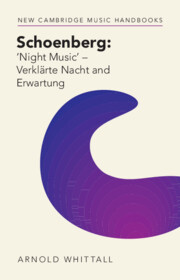Book contents
- Schoenberg: ‘Night Music’, Verklärte Nacht and Erwartung
- New Cambridge Music Handbooks
- Schoenberg: ‘Night Music’, Verklärte Nacht and Erwartung
- Copyright page
- Contents
- Musical Examples
- 1 Prelude
- 2 Verklärte Nacht
- 3 Before Erwartung
- 4 Erwartung
- 5 After Erwartung
- Select Bibliography
- Index of Works by Schoenberg
- General Index
5 - After Erwartung
Published online by Cambridge University Press: 30 November 2023
- Schoenberg: ‘Night Music’, Verklärte Nacht and Erwartung
- New Cambridge Music Handbooks
- Schoenberg: ‘Night Music’, Verklärte Nacht and Erwartung
- Copyright page
- Contents
- Musical Examples
- 1 Prelude
- 2 Verklärte Nacht
- 3 Before Erwartung
- 4 Erwartung
- 5 After Erwartung
- Select Bibliography
- Index of Works by Schoenberg
- General Index
Summary
Although Pierrot lunaire (1912) is technically more radical than Erwartung in some ways, with its pervasive use of ‘speech-song’ vocal technique, it requires only six performers and complements Night Music features with less expressionistic episodes. Since setting Stefan George’s vision of spiritual aspiration in the finale of the second quartet, then contemplating the musical legacy of Mahler and its exploration of transcendent spiritual states, Schoenberg brought consideration of his own relationship with Judaism into an ambitious plan for an oratorio, Die Jakobsleiter. As part of this characteristically far-seeing exercise in rethinking basic principles, he also moved towards the formulation of what became known in the 1920s as the twelve-tone method. Cultural attitudes changed greatly after World War I, and Schoenberg was not impervious to the neoclassical retreat from expressionism. Yet his motivic techniques (not least the variously ordered pitch-class collections formed from the letters of his own name) survived transformation from the pantonality of his earlier music into more systematically ordered twelve-tone compositions. Often making explicit allusions to tonal principles and traditional formal designs, he retained the textural flexibility and expressive intensity of the Night Music years. Elements of technique and ethos already implicit in Verklärte Nacht and Erwartung found new purpose in compositions that left the post-Wagnerian spirit of Schoenberg’s Viennese years far behind.
- Type
- Chapter
- Information
- Schoenberg: ‘Night Music' – Verklärte Nacht and Erwartung , pp. 88 - 110Publisher: Cambridge University PressPrint publication year: 2023

